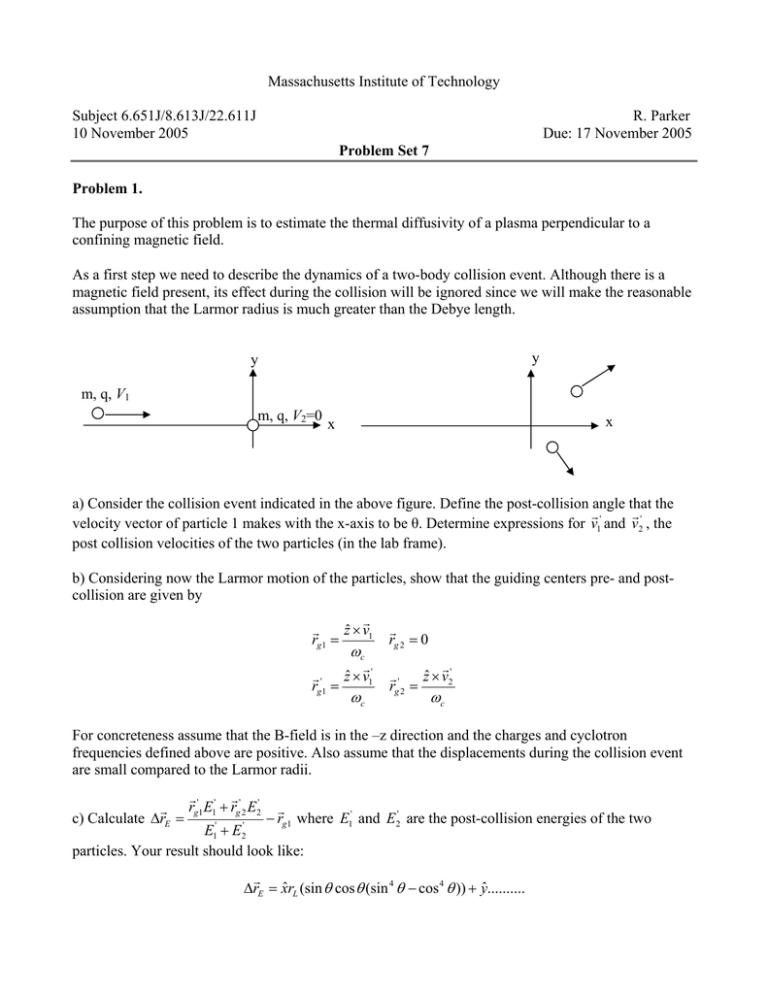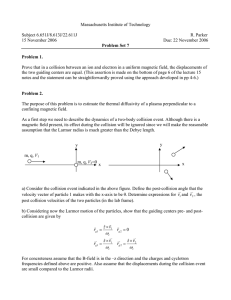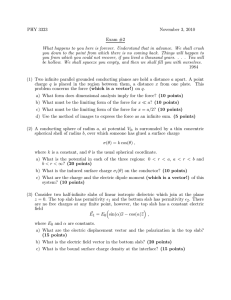Massachusetts Institute of Technology Subject 6.651J/8.613J/22.611J R. Parker
advertisement

Massachusetts Institute of Technology Subject 6.651J/8.613J/22.611J 10 November 2005 R. Parker Due: 17 November 2005 Problem Set 7 Problem 1. The purpose of this problem is to estimate the thermal diffusivity of a plasma perpendicular to a confining magnetic field. As a first step we need to describe the dynamics of a two-body collision event. Although there is a magnetic field present, its effect during the collision will be ignored since we will make the reasonable assumption that the Larmor radius is much greater than the Debye length. y y m, q, V1 m, q, V2=0 x x a) Consider the collision event indicated in the above figure. Define the post-collision angle that the r r velocity vector of particle 1 makes with the x-axis to be θ. Determine expressions for v1' and v2' , the post collision velocities of the two particles (in the lab frame). b) Considering now the Larmor motion of the particles, show that the guiding centers pre- and postcollision are given by r r zˆ × v1 rg1 = r rg 2 = 0 r r ' zˆ × v1' rg1 = r r' zˆ × v2' rg 2 = ωc ωc ωc For concreteness assume that the B-field is in the –z direction and the charges and cyclotron frequencies defined above are positive. Also assume that the displacements during the collision event are small compared to the Larmor radii. r' ' r' ' r rg1 E1 + rg 2 E2 r − rg1 where E1' and E2' are the post-collision energies of the two c) Calculate ∆rE = ' ' E1 + E2 particles. Your result should look like: r ∆rE = xˆrL (sin θ cos θ (sin 4 θ − cos 4 θ )) + yˆ .......... d) Estimate χ by the relation ∞ r d r2 χ~ ∆rE ~ nVth ∫ ∆rE2 (V1 = Vth )2πbdb dt 0 Evaluate the integral only to order ln Λ . (Hint: Express sinθ and cosθ in terms of b.) Which is dominant, ion or electron thermal diffusivity across the field? Problem 2. The left figure shows a plane wave normally incident on a plasma slab. The plasma has a dielectric constant given by ε = ε 0 (1 − ω p2 ). ω2 H E H k E θ k a) Calculate the reflection coefficient Γ defined by Γ= E ref Einc where E ref is the complex amplitude of the electric field of the reflected wave. For what frequencies is the incident power totally reflected? Evaluate numerically for a peak ionospheric density of 1012/m3. Note: For those not familiar with this type of problem, assume a transmitted and reflected wave, and match the tangential components of E and H across the slab interface. Solve for the reflected electric field amplitude. b) Repeat part a) for the case where the wave vector makes an angle θ with respect to the normal to the slab as indicated in the figure on the right. In the numerical calculation assume that the angle of incidence is 45°. Note that the direction of the electric field is normal to the “plane of incidence” defined by the wave vector and the normal to the slab.





